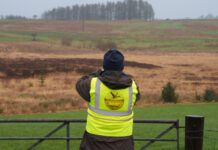
After a recent shutdown at a French nuclear power plant due to the clogging of cooling tunnels by fish, industry experts have warned that new UK-based nuclear power plants will face the same issues – and they’re offering an acoustic deterrent system they say has a track record in resolving the problem.
Sprats, a breed of fish that travel in large schools, have a history of clogging up nuclear power station cooling tunnels [1] – causing expensive and dangerous shutdowns. Sprats are also prevalent in the waters around Hinkley Point C (under construction) in Somerset and the planned Sizewell C plant in Suffolk.
Post-Brexit, the UK is working to revive its fishing industry and conservation, with campaigns like REAF in Lowestoft. The UK government is providing £23 million in support to the fishing industry and the Blue Marine Foundation is calling for National Sea Parks to be created.
At the same time, Hinkley Point C and Sizewell C power stations are being built without the full protection of the three fish mitigation measures requested by the Environment Agency. The risk of millions of fish deaths, alongside the clogging of cooling tunnels, is in direct conflict with measures that aim to protect marine life and the efficiency of the UK’s energy mix, and also with the intention to grow Britain’s fishing industry.
A seemingly proven solution to fish clogging is the UK-developed Acoustic Fish Deterrent (AFD). This technology, developed by Fish Guidance Systems, is presented as best practice and is already installed at a nuclear power station in Belgium. At Hinkley Point C it is currently part of the Development Consent Order (DCO).
AFDs use sound to influence the behaviour of fish to deflect and deter them from entering the intakes. EDF has removed this from its proposal for Sizewell C, and at Hinkley Point C a public enquiry is now underway because EDF is requesting a material change to the DCO to remove the AFD.
David Lambert, Managing Director of UK-based Fish Guidance Systems , a company that has been developing AFDs over the last 25 years, said: “As scientists and environmentalists we have spent over 25 years working on acoustic fish deterrents (AFD). We know that AFDs can reduce sprat entrainment by 87.9% and herring deflection by 94.7%, which aids in the prevention of fish inundation at nuclear power plants. Environmentally and financially, mitigating the risk of fish clogging and millions of fish dying is essential to the UK’s future.”
The remaining two mitigation measures of a fish return system and low-velocity intake are not adequate to prevent millions of fish from dying in the cooling system.
Fish species at risk in the North Sea and Severn Estuary are sprat, Atlantic salmon, sea trout and twaite shad. Bradwell B in Essex is the next proposed power station. The same issues will be present at this station creating multiple sites that are in conflict with the ecology and business interests of the UK.
Notes
[1] Examples of fish shutting down nuclear power plants:
Kincardine Generating Station, Scotland, 1962:
This power station became overwhelmed with Sprat clogging the drum screening chambers on 19 December 1962. It was taken out of service on the 19th because it was impossible to keep its auxiliary cooler strainers clean. It was returned to service until the 23rd, but then it became necessary to clean the main condenser. On the 27th it was again restored to service.
Sizewell A Power Station, January 1969:
1967 was a particularly abundant year for the sprat population along the east and south-east coast of England. As much as 70% came from the Suffolk coast. It first became clear that the numbers of sprat were high in the second week of November 1968. This was because large concentrations of shoals had begun to build along the Suffolk coast. January 10 1969 – a large quantity of sprat rapidly clogged the filter screens to the point that the weight was enough to break through the screens and into the plant. The local inspector of fisheries estimated that fish had been washed ashore over a total of 6-7 miles, weighing around 30 tonnes. On a more recent occasion, 33 tonnes of sprat were drawn in by Sizewell A, out of a total of 36 tonnes of fish in the whole year.
Dungeness Power Station 1969:
This incident took place in January 1969, about a week after the incident at Sizewell. It seemed to be an exact carbon copy of what happened at Sizewell. Both Sizewell and Dungeness intakes are both situated in potential danger zones regarding sprat shoals.
Dungeness Power Station 1999
More recent inundations have also been reported at Dungeness, in 1999 the band screens were damaged during a sprat inundation, and the screens had to be refurbished.
Dungeness Power Station 2000
In February 2000 the station was closed for three days at a cost of more than £1m (2000 prices) when a large shoal of sprat was drawn into the two intakes and inundated the cooling water system, overwhelming the cleaning capacity of the band screens.
Other sites around the UK have also been affected by fish inundations in the past, including Longannet, Kincardine Bridge and Peterhead.






